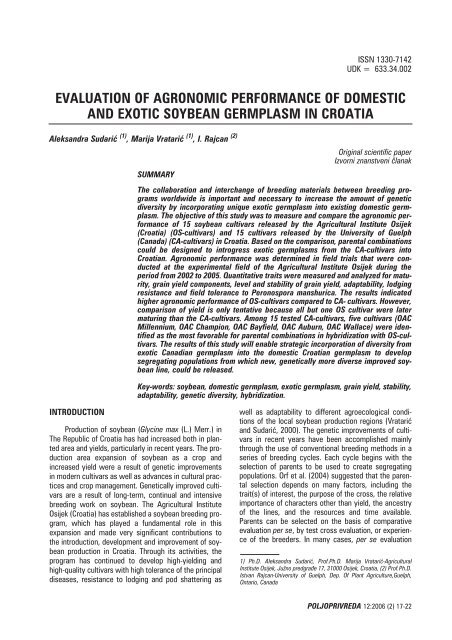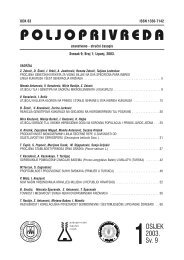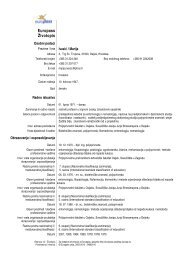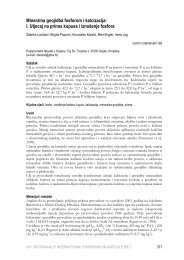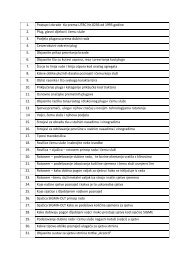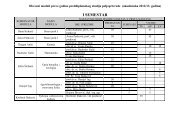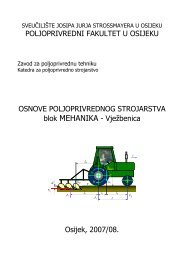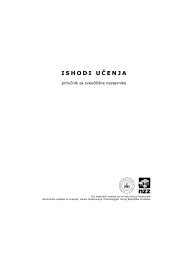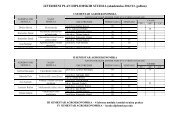Poljoprivreda 2-2006 final.qxd
Poljoprivreda 2-2006 final.qxd
Poljoprivreda 2-2006 final.qxd
You also want an ePaper? Increase the reach of your titles
YUMPU automatically turns print PDFs into web optimized ePapers that Google loves.
ISSN 1330-7142<br />
UDK = 633.34.002<br />
EVALUATION OF AGRONOMIC PERFORMANCE OF DOMESTIC<br />
AND EXOTIC SOYBEAN GERMPLASM IN CROATIA<br />
Aleksandra Sudarić (1) , Marija Vratarić (1) , I. Rajcan (2)<br />
SUMMARY<br />
Original scientific paper<br />
Izvorni znanstveni članak<br />
The collaboration and interchange of breeding materials between breeding programs<br />
worldwide is important and necessary to increase the amount of genetic<br />
diversity by incorporating unique exotic germplasm into existing domestic germplasm.<br />
The objective of this study was to measure and compare the agronomic performance<br />
of 15 soybean cultivars released by the Agricultural Institute Osijek<br />
(Croatia) (OS-cultivars) and 15 cultivars released by the University of Guelph<br />
(Canada) (CA-cultivars) in Croatia. Based on the comparison, parental combinations<br />
could be designed to introgress exotic germplasms from the CA-cultivars into<br />
Croatian. Agronomic performance was determined in field trials that were conducted<br />
at the experimental field of the Agricultural Institute Osijek during the<br />
period from 2002 to 2005. Quantitative traits were measured and analyzed for maturity,<br />
grain yield components, level and stability of grain yield, adaptability, lodging<br />
resistance and field tolerance to Peronospora manshurica. The results indicated<br />
higher agronomic performance of OS-cultivars compared to CA- cultivars. However,<br />
comparison of yield is only tentative because all but one OS cultivar were later<br />
maturing than the CA-cultivars. Among 15 tested CA-cultivars, five cultivars (OAC<br />
Millennium, OAC Champion, OAC Bayfield, OAC Auburn, OAC Wallace) were identified<br />
as the most favorable for parental combinations in hybridization with OS-cultivars.<br />
The results of this study will enable strategic incorporation of diversity from<br />
exotic Canadian germplasm into the domestic Croatian germplasm to develop<br />
segregating populations from which new, genetically more diverse improved soybean<br />
line, could be released.<br />
Key-words: soybean, domestic germplasm, exotic germplasm, grain yield, stability,<br />
adaptability, genetic diversity, hybridization.<br />
INTRODUCTION<br />
Production of soybean (Glycine max (L.) Merr.) in<br />
The Republic of Croatia has had increased both in planted<br />
area and yields, particularly in recent years. The production<br />
area expansion of soybean as a crop and<br />
increased yield were a result of genetic improvements<br />
in modern cultivars as well as advances in cultural practices<br />
and crop management. Genetically improved cultivars<br />
are a result of long-term, continual and intensive<br />
breeding work on soybean. The Agricultural Institute<br />
Osijek (Croatia) has established a soybean breeding program,<br />
which has played a fundamental role in this<br />
expansion and made very significant contributions to<br />
the introduction, development and improvement of soybean<br />
production in Croatia. Through its activities, the<br />
program has continued to develop high-yielding and<br />
high-quality cultivars with high tolerance of the principal<br />
diseases, resistance to lodging and pod shattering as<br />
well as adaptability to different agroecological conditions<br />
of the local soybean production regions (Vratarić<br />
and Sudarić, 2000). The genetic improvements of cultivars<br />
in recent years have been accomplished mainly<br />
through the use of conventional breeding methods in a<br />
series of breeding cycles. Each cycle begins with the<br />
selection of parents to be used to create segregating<br />
populations. Orf et al. (2004) suggested that the parental<br />
selection depends on many factors, including the<br />
trait(s) of interest, the purpose of the cross, the relative<br />
importance of characters other than yield, the ancestry<br />
of the lines, and the resources and time available.<br />
Parents can be selected on the basis of comparative<br />
evaluation per se, by test cross evaluation, or experience<br />
of the breeders. In many cases, per se evaluation<br />
1) Ph.D. Aleksandra Sudarić, Prof.Ph.D. Marija Vratarić-Agricultural<br />
Institute Osijek, Južno predgrađe 17, 31000 Osijek, Croatia, (2) Prof.Ph.D.<br />
Istvan Rajcan-University of Guelph, Dep. Of Plant Agriculture,Guelph,<br />
Ontario, Canada<br />
POLJOPRIVREDA 12:<strong>2006</strong> (2) 17-22


